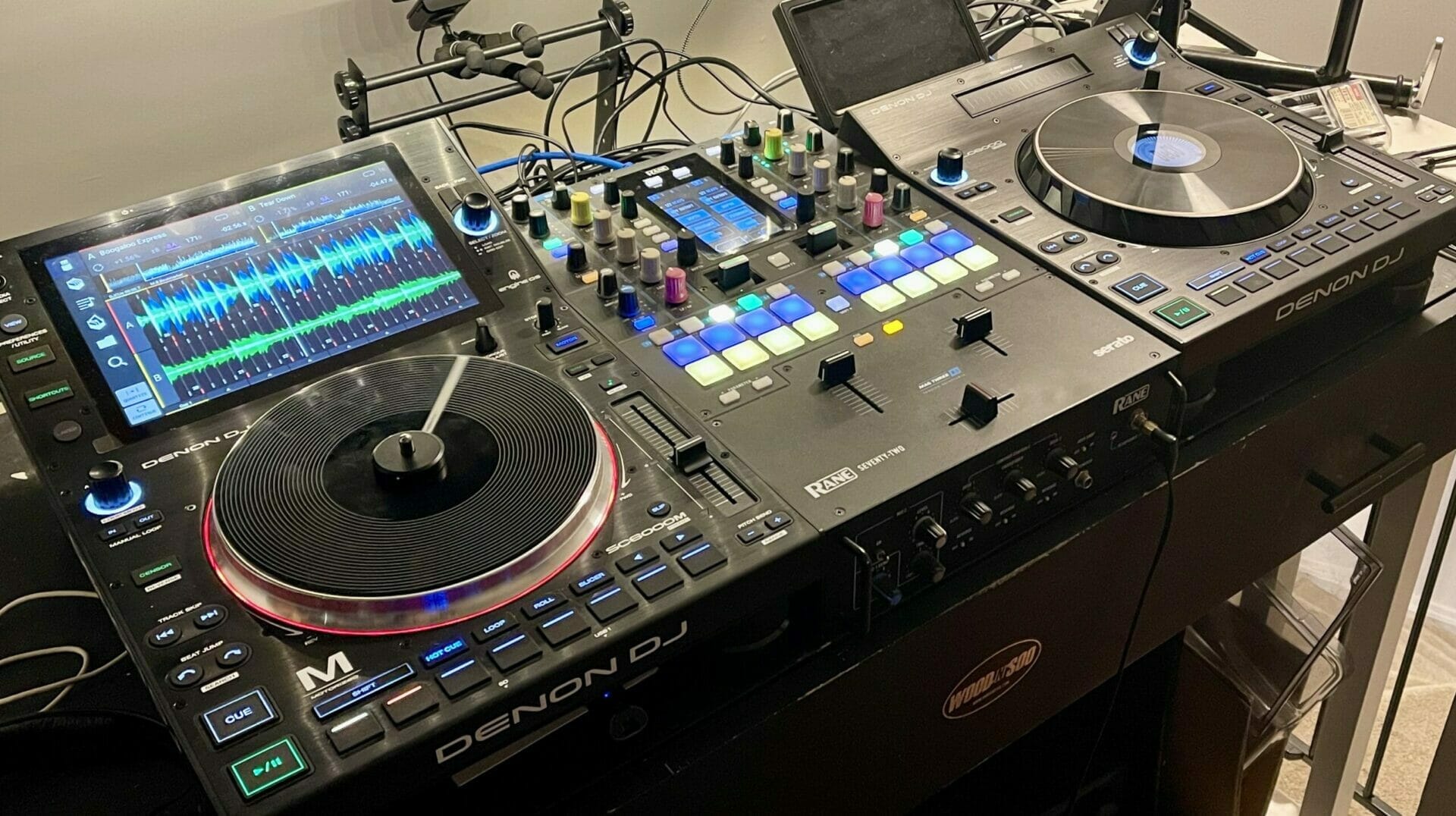InMusic is never one to keep things too close to the vest. Over the years, we have seen so many different leaks about their various products (many of them from Rane). We often seem to find out about their upcoming releases long before they’re “officially” announced. Whether this is by design or a lack of NDA enforcement is up for some debate. What is not up for debate, however, is their ability to build hype – whether intentionally or unintentionally – around these products.
Late last year, we were witness to yet another leak. In an Instagram story posted by Laidback Luke, a mysterious Denon DJ branded controller appeared in the background. With this player lacking the signature screen, the internet exploded with speculation as to its function. Was this a cheaper version of the Denon DJ Media Players? Or was it a separate MIDI controller to control the 2nd layer on the Denon DJ Media Players?
Back in January, DJ Pierre streamed a set for a Beatport-sponsored livestream event, and we finally saw these players in action. As expected, these decks seemed to be sub-controllers for the Denon DJ Media Players.
Denon DJ‘s much-touted dual-layer function has always been one of their more significant selling points. The ability to use a single deck to mix two tracks upped the cost-effectiveness of their units considerably. You could easily DJ with a single deck – something that was only really possible on laptop systems for the last several years. A pair of players could run four-deck mixing for the cost of just two decks. This would mean a two or four-deck mixing experience at a significantly reduced cost.
Not a new idea – but a much-appreciated one.
Contenido
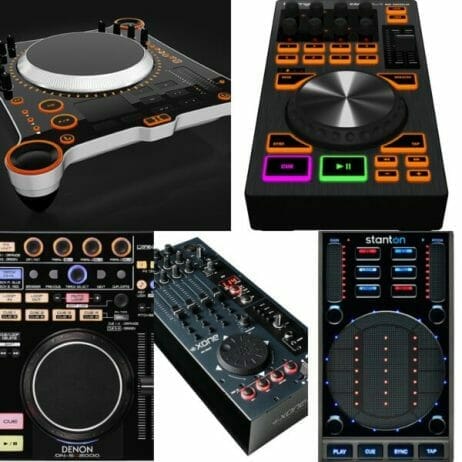
Modular platter controllers have been around for a long time now. Back in the late ’00s and early ’10s, DJ companies were still trying to figure out the future of DJing. As a result, several companies threw everything at the wall to see what would stick. Among them, modular platter-based MIDI controllers were abundant. Everyone from Allen & Heath amd Behringer to Stanton to lesser-known companies like EKS and even Denon DJ had modular, platter-based controllers. None of them took off for various reasons. Eventually, we settled on the familiar standards of CDJs, turntables with DVS, and all-in-one controllers for the better part of the decade.
Fast forward to 2021. Denon DJ is revisiting the idea of a modular, platter-based MIDI controller with the LC6000 Prime.
So, what makes the LC6000 Prime different? Let’s find out.
How it works

At its heart, the LC6000 Prime is simply a controller. It doesn’t produce any audio and functions entirely as an HID controller.
Unlike many platter controllers of the past, the biggest leap forward with this is its compatibility with Denon DJ Media Players. Previously, these types of controllers could only be used with laptop software (and back then, you were pretty much relegated to Traktor).
The LC6000 Prime can control the secondary layer on a Denon DJ Media Players or software on a laptop or tablet/phone. It connects via a standard USB-B jack and is powered by either USB bus power or via an included power supply. In standalone mode, the USB cable connects directly to any three USB ports meant for music drives on the Denon DJ Prime media players. The players provide enough output to power the LC6000 Primes without a power supply.
The LC6000 Prime controls the secondary layer on a player. You can use a single Denon DJ Media Players and the LC6000 Prime or use a pair in conjunction with a couple of players for the full 4-deck experience.
How it feels
Everything feels great on the LC6000. It functions and feels exactly like a Denon SC6000 Prime, only without a screen. Everything feels responsive and smooth, and I detected no latency in the standalone mode.
The unit comes fully mapped out of the box and functions pretty flawlessly. The new stacked waveform view in Engine OS 1.6 is also perfect for mixing off a single player and the LC6000.
Layout
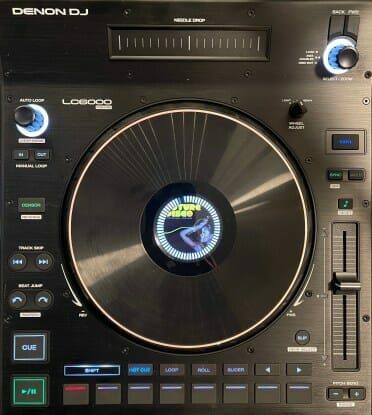
At first glance, the LC6000 Prime looks almost identical to an SC6000 Prime in layout. The most obvious difference is the touch strip that replaces the screen. This strip functions as a needle search that you would find on several controllers out there. Also missing is the stop time knob, which mirrors the connected Denon DJ Media player’s setting instead. Other than that, the buttons and placement are all the same as the SC6000 layout. The platter is the same 8.5″ capacitive touch jog wheels found on the SC6000, complete with the circular screen. The screen displays platter positioning and track art exactly, like – you guessed it – the SC6000s do.
Those familiar with Denon DJ Prime decks will be immediately comfortable using the LC6000s.
Build
The LC6000 Prime feels well-made and on par with the Denon DJ Prime media players. The chassis consists of a plastic base and a metal faceplate, precisely like the SC6000 players. Everything from the materials to the components is identical to the SC6000 line. The metal has a nice brushed texture, and the plastic has this rubberized coating that has a bit of a grippy feel to it – which I find quite pleasing to the touch.
The LC6000 is substantially lighter, though – to the extent that it almost feels slightly too light and hollow at a little over 6 lbs. This lightness is due to the lack of any screen or the substantial electronics that drive the Engine Prime media players. While it certainly doesn’t feel cheaply made, there’s a certain expectation that they will weigh similar to an SC6000 – which it certainly doesn’t. This feeling is purely psychological, mind you, as the overall build seems solid.
Buttons, knobs, and faders
The buttons on the LC6000 feel great and are the same as the SC6000 players. Unlike the SC5000, which contained a mixture of hard plastic and rubber buttons, nearly all the buttons in the LC6000 are the rubbery type. The only buttons that consist of the more rigid plastic are the Shift button and the Back and Forward buttons above the Track Selection encoder. As is standard for Denon DJ, the buttons tend to click instead of acting like pads on a DJ controller or battle mixer. The button components seem much better by all reports than those on the SC5000 – which have seen complaints online in various forums. Time will tell with the longevity of the button with these 6000 units, though.
There are minimal knobs and only a single fader for the pitch. The encoders are metal-stemmed and have a decent, chunky feel to them. The pitch fader feels excellent: smooth, satisfying, and with a nice amount of resistance to them.
Connections
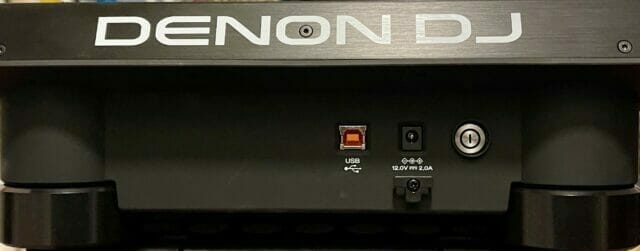
As this is purely a MIDI controller, there aren’t many ports to speak of. You’ll find a standard USB-B port and a DC jack for power. As mentioned, the LC6000 Prime is fully USB bus-powered. This means the power cable is optional and only really needed if using an unpowered USB hub. Because it is a MIDI controller, the LC6000 doesn’t really need a ton of power run. Even the somewhat-underpowered USB hub on the Rane mixers are enough to run them.
Software Compatibility
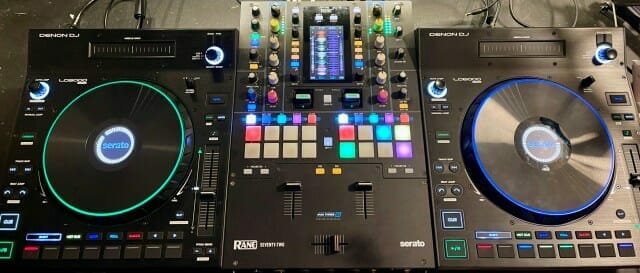
The LC6000 Prime officially supports Serato DJ Pro, Virtual DJ, and DJay Pro (both laptop and tablet/phone). Given the open nature of Traktor Pro 3, it can likely be MIDI mapped, and I do not doubt that someone will figure out a good mapping template for Traktor. Rekordbox is the only real odd one out, as Pioneer DJ still does not allow for custom mapping of platter functions – and it’s implausible they will ever natively support anything by Denon DJ.
You can connect up to 4 LC6000 Primes via USB so long as your hardware supports four decks. It functions perfectly well with built-in USB hubs and powered USB hubs. If you are using an unpowered hub, you do need to plug in the LC6000s to a power supply.
The Pros
Cost-effectiveness
With an MSRP of $699 USD, you will pay drastically less to get two or four-deck control. Instead of buying two players, you can get a single SC6000 and an LC6000 for 2/3rds of the cost. Likewise, you can have a full, four-deck setup for a substantially lower price tag. That is some substantial bang-for-buck for a premium standalone setup and arguably the best feature-set and UX on the market.
Flexibility and versatility
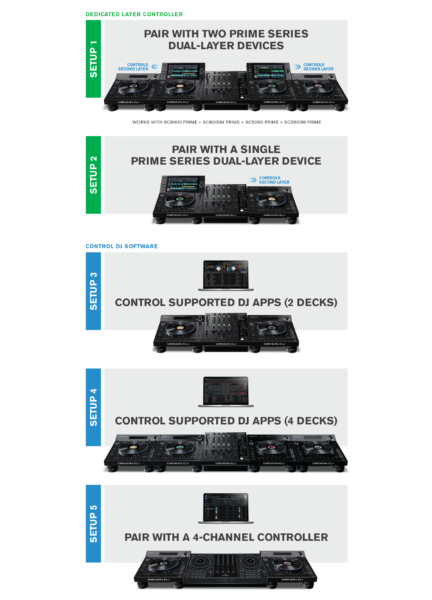
The LC6000 is quite a versatile unit. As mentioned, you can use one with any of the Denon DJ Prime media players and get a full two-deck setup. Adding a pair to an existing set of players gives you four decks ready to go. Get two or four LC6000s and use them as a set of platter controllers with a mixer for your supported laptop suite of choice. You can even connect a pair of them to a four-channel controller and give yourself an extra set of platters. It is even possible to control all four decks in a laptop program using a single LC6000 Prime. This versatility makes the LC6000 a flexible option for various types of Djs.
Compatibility via plug and play
As mentioned, many of the previous platter controllers didn’t take off over the years. Part of the reason was the lack of complete MIDI mappings out of the box. Many pieces of gear either expected you to do the MIDI map yourself or rely on others to make it. Custom MIDI mapping is not always the most straightforward task and can be frustrating for many. Add to the locked nature of popular programs like Serato, and a lot of these platter controllers just never connected with the zeitgeist.
With the LC6000 Primes, you get instant plug-and-play compatibility with three major software suites. Use up to four of the LC6000s to control any partnered software – all pre-mapped and ready for instant use as soon as you plug it in. The convenience of this functionality cannot be understated.
Consider that before this, the only current options for a modular HID deck to control software was either the fairly minimalistic (and heavy) Rane Twelves or a standalone player like the Denon DJ Prime Media players or specific Pioneer CDJs that featured HID support. Now, Djs who want an HID deck for Serato or VDJ no longer need to pay the extra premium for standalone support if they don’t need it.
Stacked waveform view with two decks
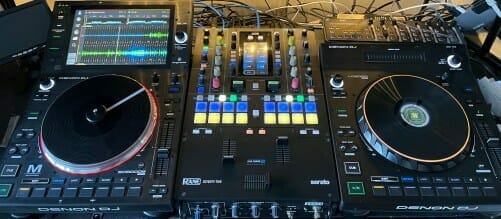
Surprisingly, I prefer playing on a single SC6000 and an LC6000 to a pair of players. The stacked waveforms are just a more comfortable view for me, and you can’t use this view when using a set of players. When used with the LC6000 Prime, the stacked waveform view shines.
The Cons – and improvements we’d like to see
The platters
I was not too fond of the SC5000 platter. I found it too heavy, and it didn’t have the best responsiveness – especially when it comes to scratching. While I think the SC6000 platter is a vast improvement over that of the SC5000, I’m still not entirely sold on its feel. It’s still a little on the heavy side, even on the lightest tension setting. From my experience, it just doesn’t feel as smooth and responsive as the mechanical platters found on Pioneer gear (and I hear the CDJ-3000 platters are even better). The LC6000 has the same platter, and therefore the same criticisms apply.
I’d also like to see more track information on the platter screen – perhaps the track’s BPM or key. I know all that information is readily available on the player itself (especially in stacked view), but just a little more relevant information would improve the experience.
Slightly pricey
The cost of a single SC6000 and an LC6000 is considerable savings for what you get. That said, $699 still seems a little high for a MIDI controller with no audio interface. Of course, it is undoubtedly cheaper than buying a second SC6000. While the overall feature-set and quality level seem pretty high, it is ultimately a MIDI accessory that does very little on its own without a full Denon DJ Media player or a laptop-based program and supported hardware. Consider also that the LC6000 costs as much as an XDJ-700.
A spinning platter version
I want an LC6000M. It’s that simple. A vocal subset of Djs has been clamoring for a smaller version of the Rane Twelves, and others have been demanding something with more controls built into the player itself. A version of the LC6000s based on the SC6000Ms would fit that bill perfectly. With that, though, the question is whether Denon DJ can add spinning platters at an affordable uptick in price. From what I understand, the cost of a motor is the same regardless of the size. I would expect – at the very least – the same $200 difference between the cost of the SC6000 and SC6000M if such a player ever happens.
Final Thoughts
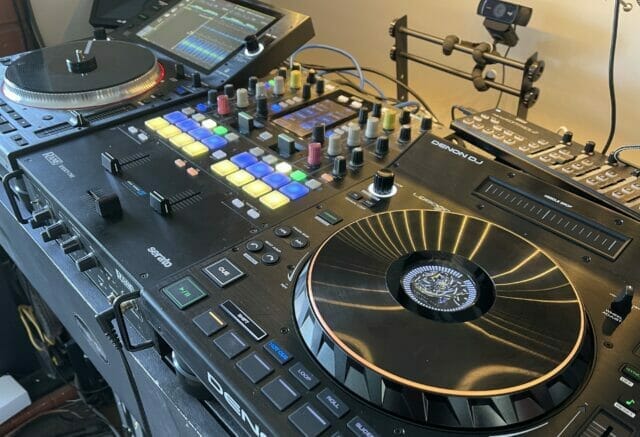
Those used to my novel-length reviews might be surprised at this one. I get that this is one of my more straightforward reviews, but the LC6000 Prime is a fairly straightforward product.
With the Denon DJ LC6000 players, there aren’t many hidden functions or crazy unexpected features to uncover. What you see is what you get with it. At its core, the LC6000 Prime is a MIDI controller that mirrors the layout and controls of the Denon DJ SC6000 series players with the same build quality. It also works with several different setups beyond just the Denon DJ ecosystem.
Is it some groundbreaking design that will turn the DJ world on its head? No, not really.
Taking cues from the past
Here’s the thing about InMusic’s recent offerings: many of their latest products aren’t that new or original in terms of concept. Many of their ideas are born from past ideas and designs. The Rane Twelves are a take on the Stanton SC.01, Numark V7s, or a few other spinning platter controllers. The DJM S9 heavily influenced the design of the Rane Seventy. Of course, the Rane ONE is more or less a reimagining of the Numark NS7. Denon DJ has been in the game, making CD and standalone players for years now. Denon DJ, Numark, and of course, Technics offered spinning platter CDJs as far back as the early 2000s. Dual-layer functionality from a single player has been around since the DN-S5000 players way back in the early 2000s.
Using the controller with a standalone player is probably the biggest innovation on the LC6000 Prime.
Innovation? Not really. Not really needed either
Sure, the LC6000 Prime isn’t exactly an innovative product for all intents and purposes – but it doesn’t have to be.
At its core, the LC6000 is a fully-featured, add-on controller that you can plug into a variety of different setups with no fuss. While previous attempts at platter controllers have never taken off, the LC6000 looks to buck that trend. Official compatibility with multiple software in addition to Denon DJ standalone players makes this one of the most versatile – and easy to use – accessory controllers on the market.
Modular gear finding a new audience?
I also spend a lot of time in DJ forums and online communities (probably more than healthy). I have noticed, anecdotally, that there’s a renewed interest in modular gear in recent years. An entire generation of Djs came up almost exclusively with all-in-one controllers in the early and mid-10s and only experienced higher-end modular setups in specific venues. And for many, the Pioneer CDJ setup is still financially out of reach for many Djs. Even the more affordable offerings aren’t exactly cheap. Consider that the cost of a full, four-deck, flagship Pioneer DJ setup would cost as much as some cars.
Bang for your buck
“Affordability” is a bit of a relative notion. The Denon DJ gear is “affordable” when compared to, say, Pioneer DJ Gear. But ultimately, $699 per unit is not cheap – especially if you need to buy two units – and especially because the main purpose is to use it with more expensive gear.
With that said, the LC6000 Prime is ultimately a premium controller meant for use with Denon DJ’s flagship standalone gear. With the LC6000, the barrier of entry into premium standalone DJing drops drastically. The cost of a proper, four-deck setup, with four jog wheels at your fingertips, almost zero compromises to features likewise comes way down. Djs can even experience the two-deck experience of the flagship Denon DJ Prime standalone products for less than the cost of a single CDJ 3000.
Who is this for?
The LC6000 Prime is a bit of a swiss army knife for DJing. Sporting compatibility with so many different types of software and hardware, a range of Djs can find a use for this controller. The best way to look at it is that the LC6000 Prime is Denon DJ’s version of the Rane Twelves.
The LC6000 Prime may be up your alley if you fall into one of these categories:
- Denon DJ Prime users looking to expand to four-deck control
- Djs looking for a more cost-effective way to play standalone on two decks
- Laptop Djs seeking a feature-packed platter controller to run HID without paying extra for the standalone capabilities
- Mobile Djs looking for an elegant and premium-looking modular setup at considerably less weight
- Controller Djs looking to get some extra platters to control 4 decks
Something like the LC6000 Prime likely isn’t going to sway the die-hard Pioneer DJ fans out there. This new controller won’t convert those who dislike the Denon DJ experience or aren’t convinced of the viability of the Denon DJ lineup vs. the more field-tested CDJ lineup. But for those looking for an elegant, intuitive, and feature-packed standalone experience without having to pay the full price, an SC6000 and the Denon DJ LC6000 Prime might be the product that helps nudge some towards the new kid on the block.
The LC6000 Prime will be available in the coming months at a price point of $699 US. In the meantime, you can check out more about its features in this Denon DJ video.

